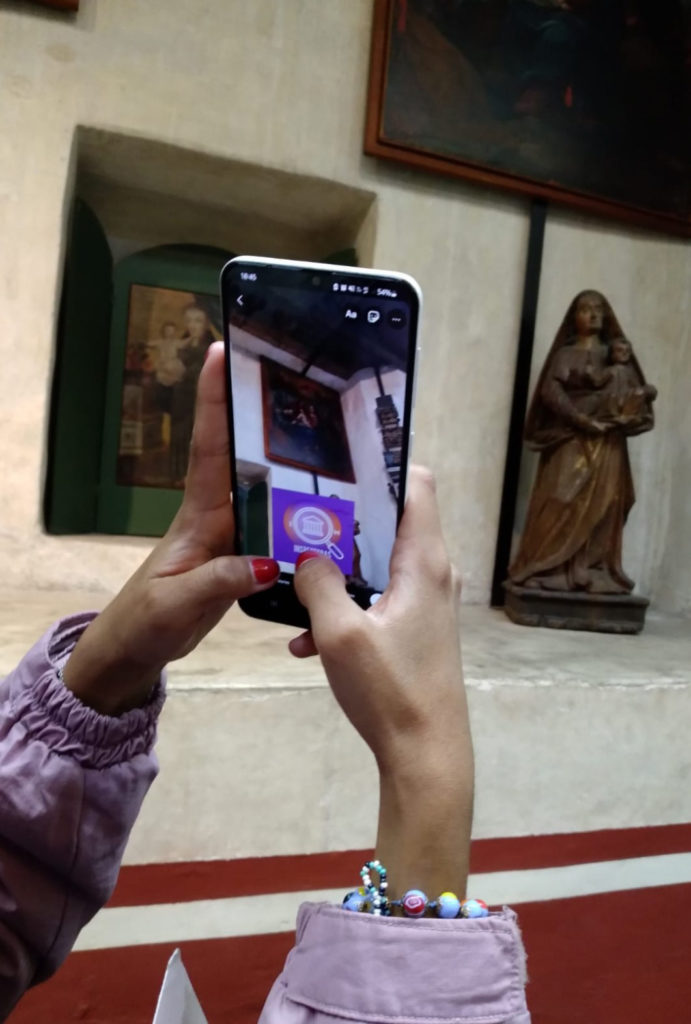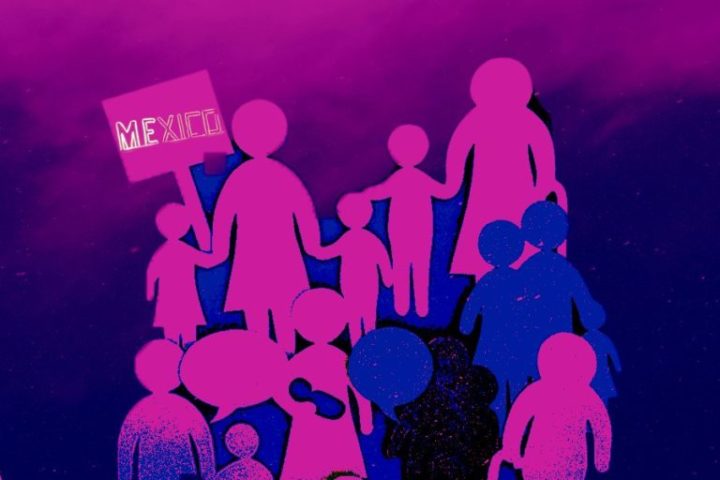This article was published in Spanish in issue 10 (2023) of the journal Chaski, published by ICOM LAC (ICOM Regional Alliance for Latin America and the Caribbean). It has been translated into French and English for publication in the ICOM Voices series.
Jessica Ramírez is a graphic designer with an interest in gender studies, and a doctoral candidate in Art and Design at the Universidad Nacional Autónoma de México [National Autonomous University of Mexico]. She works for ICOM Mexico and the Antonio Haghenbeck Cultural Foundation. She has worked in foundations and NGOs linked to museums, art and feminism, such as the Red Nacional de Refugios [National Network of Refugees], the Seminario de Investigación Museológica [Seminar for Museological Research] and the Coalición de Mujeres Rurales [Rural Women’s Coalition].
Citizenship and cultural action in museums
Through social struggles, political action and many forms of social and cultural resistance, society has developed processes of sovereingty and transformation to fully establish its rights and exercise its citizenship. In this sense, citizenship refers to ‘a series of cultural, symbolic, political and economic practices which define the nature of rights and obligations within a state’ (Limón and Real, 2019), while sovereingty is defined as freedom and independence; in other words, to have the tools to grow and develop in a space of coexistence and dialogue (Bobbio, 2002). Both concepts converge in the process of actively participating in society.
All individuals, without exception, through the exercise of their human rights, should have access to certain essential aspects of life, which include culture. The UNESCO Declaration on Cultural Diversity sets out the right to participate in cultural life individually and collectively, to benefit from and build on scientific progress and its applications, to have one’s moral and material interests protected (in terms of scientific, literary and artistic production), to have the necessary freedom to undertake scientific research or creative activities.
As such, states must provide the tools to protect and guarantee these rights and ensure that they can be equally exercised by diverse groups in which culture is developed. To achieve this, States must be able to rely on five fundamental principles: availability, accessibility, acceptability, adaptability and suitability, all of which should be implemented in museums.
Citizens labs in museums: inclusion of gender perspectives
Using the ideas discussed here as a starting point, museums have the potential to foster safe spaces of reflection, to activate artistic, cultural and scientific configurations with the aim of making violence against women more visible.
Previously, audience research has brought the voice of visitors into museums, enabling direct interaction with them and their inclusion in the museological and museographic processes during the planning, design and production phases of exhibitions. However, despite these efforts, their results often do not arrive at practical solutions and remain purely analytical.
In this context, CILs (Citizen Innovation Labs) are an alternative solution to involve people in direct action, where the consulting aspect is part of the process but not its objective. Indeed, the concept of innovation, and specifically involving citizen participation, is generally considered as such when a new process is created, or an existing process is improved (Godín, 2008).
The horizontal nature of CILs’ methodology differentiates it from other kinds of innovation due to its civic dimension: the centre of action is the citizens, and their feedback is included (through evaluating their abilities, knowledge, needs and contexts). As such, this methodology adapts to multiple realities, reaches levels of syncretism, implication and listening to what we can call ‘communities of knowledge’ or ‘societies of knowledge’ (García, 2004) and ‘peer-circulated networks which have proved themselves key actors in building the Web, open source softwares and Wikipedia’ (García, 2018). In this way, the guiding threads of CILs’ methodology are experimentation, uncertainty/error and trust, which are an essential part of any cooperative space seeking to resolve problems.
In this sense, CILs are spaces of encounter for creating diverse templates, which offer improvable solutions that can adapt to new experiences (Pascale & Resina, 2020). However, CILs’ impact can also resonate in public politics, moving from neutrality to social change (Criado, 2015). To render this possible, there are three necessary components: horizontal dynamics, tools for mediation and an environment of constant experimentation aimed at creating open knowledge and culture.
The logic behind CILs’ participatory and multi-level approach is one of the key pillars of its innovation model (Arnkil, 2010), it allows for the widening of ‘open innovation’ and different forms of social innovation expressed in the form of ‘co-working’ or ‘sharing economy’ spaces. To create these ‘open innovation’ spaces, the involvement of various stakeholders is essential: government, industry, education and citizens need to get involved and interact.
The ‘Laboratory: Women in the Museum’ initiative
The objective of this article is to present an initiative on the way women’s citizenship is considered in museums. This initiative was carried out by the Observatorio de Museos Raquel Padilla Ramos or OMRPR [Raquel Padilla Ramos Museum Observatory], a Mexican collective that seeks to transform, propose and carry out actions to dismantle the patriarchal perspective of discussions in museums. It was started by women working at the Instituto Nacional de Antropología e Historia (National Institute of Anthropology and History), which supervises 162 museums, in response to the femicide of anthropologist Raquel Padilla. Working directly with citizens is one of the aims of the OMRPR, which is why it used LICs in 2020.
The ‘Laboratoria : Mujeres en el Museo’ [Laboratory: Women in the Museum] initiative was organised by OMRPR, and more than 70 women working in varied disciplines and from different origins participated. Together, they created templates which consider gender issues. This CIL relied on the support of INAH and the backing of MediaLab Prado. They developed two projects ‘Divulgación Significativa’ [Meaningful Outreach] and ‘Mapeo Colectivo’ [Collective Mapping], with a total of five templates:
- Breastfeeding freely
- Mapping of collaborators
- Self-diagnosis
- Exhibition evaluation
- Documentary film
These templates have been implemented in at least one museum space within INAH, whether completely or partially.
‘Female inspectors in museums’: Hybrid and feminist strategies in museums.
The ‘Lab for Participatory Reinvention in Museums’ (LPRM) initiative was developed by INAH with the objective of realising ‘proposals, alternatives approaches, strategies and methodologies on the social and community participation in museums, particularly in institutional museums’ (LABS BIBLIOTECARIOS (2022). This initiative incorporated similar actions to ‘Lab: Women in the Museum’, but with different reaches. It was carried out in collaboration with the Ministry of Sport and Culture in Spain, through the ‘Citizen Circulated Labs’ programme, in a joint action in November and December 2021.
The LRPM brought together projects that promote a cooperative space in which any interested individual or collective can have a bearing on the museum environment, independently of their professional experience. They selected three projects focusing on indigenous peoples, cities and feminism to be developed with citizens.
One of the projects presented in this lab was ‘Constructing a new gaze: feminist visual narratives in museums’ which sought to spark a series of critical ideas about the representation of human diversity in museums, to rethink, analyse and construct new narratives to dismantle the patriarchal perspective of discussions through personal citizen experiences.
Mediation played a fundamental part in creating links in the definition of objectives, goals and activities relating to these objectives, as well as in allowing open and participatory listening. Documenting each stage was also fundamental, not only for historic purposes, but also as a tool for recovering ideas and reflections within the objectives and their future definitions.
The outcome of this lab was the development of a toolbox to integrate a gendered perspective into museums from three main focuses: critical and active participation of the public (violet proposals) information on feminism and gender perspective (violet information) and documentation of feminist actions in museums (violet visibility).
For this, the ‘Female Inspectors of Museums’ was created, which relied on a series of tools/strategies in a collective and hybrid form. The project can be found on a website where the details of each activity can be found (Table 1).
| Tool | Type | Description |
| Self-reflection notebook |
Violet information |
Tool aimed at female museum workers for self-reflection on feminism and on their workspace. |
| Museum free of violence | Ten commandments that highlight actions to make museums spaces free from violence. | |
| Museum violenceometre | Image that shows the different kinds of violence that women may experience in museums. | |
| Femhackers (image 1) |
Violet proposals |
Activity that allows the public to identify and transform sexist content hacking it and sharing it on social media with the hashtag #femhackmuseums. |
| Violet peephole | Instrument that can be used to reflect on the representation of women with targeted questions | |
| Women in Museums | Activities centered around women to encourage female visitors to use their voice and give opinions in museums. | |
| Repository | Violet
visibility |
Set of actions carried out in Mexico to bring gender equality to museums. |
Table 1. Toolbox. ‘Female Museum Inspectors’ 2021.

Culture feeds on experimentation, speculation and uncertainty, through humankind’s natural tendency for amazement, learning and coexistence. As such, CILs have huge potential for action in museums to generate strategies with critical mechanisms and participatory experiences. However, there is still a long way to go to achieve target results, given the horizontal barriers, the difficulty of measuring their outcomes and their complex long-term nature.
‘Female Museum Inspectors’ and other citizen initiatives are not only examples of how it is possible to change the dynamics, work and power structures within museums; but also evidence of the need to document and disseminate the processes to make them replicable and adaptable to any space and time. The museum is the ideal mechanism to do so, given that it provides both a physical space and the possibility for mediation, resulting in the continuous development of knowledge and capabilities in dialogue with different lines of action.
The ‘Female Museum Inspectors’ has officially been implemented in the Museo Ex-convento de Culhuacán from March 2022, with experimentation workshops for women, the dissemination of ‘violet information’ and ‘femhackers’ with guided tours. This is just one example of how it is possible to shift the paradigm of participation in museums, which are ideal spaces for social sustainability, and for the continuous development of knowledge and abilities in dialogue with citizens. The museum is the bridge between past, present and future societies.
References
Arnkil, R. (2010). Explorando la cuádruple hélice. Outlineing user-oriented Innovation models. Universidad de Tampere, Centro de Investigación del Trabajo, Documento de Trabajo Nº 85.
Bobbio, N. (2002). Diccionario de política, Ed. Siglo XXI.
Criado, M. (2015). Los laboratorios ciudadanos. Un estudio de caso: El Medialab-Prado y su impacto en el ámbito local. [Tesis de maestría, Universitat Oberta de Catalunya]. http://hdl.handle.net/10609/61345
Godín, B. (2008). Innovación: la historia de una categoría. Documento de trabajo. Institut national de la recherche scientifique, Centre Urbanization Culture Société, Montréal. http://www.csiic.ca/PDF/IntellectualNo1.pdf
García, M. (2018). Los laboratorios ciudadanos en los sistemas de experimentación e innovación. Abrir instituciones desde dentro. [Hacking dentro del Libro Negro]. Laboratorio de Aragón Gobierno Abierto. https://cutt. ly/gLnZvDG
Pascale, P. y Resina, J. (2020). “Prototipando las instituciones del futuro: el caso de los laboratorios de innovación ciudadana (Labic)”. Revista Iberoamericana de Estudios del Desarrollo 9(1):6-27. DOI: 10.26754/ojs_ried/ ijds.437
LABS BIBLIOTECARIOS, El otro museo. https://labsbibliotecarios.es/proyecto/el-otro-museo/
